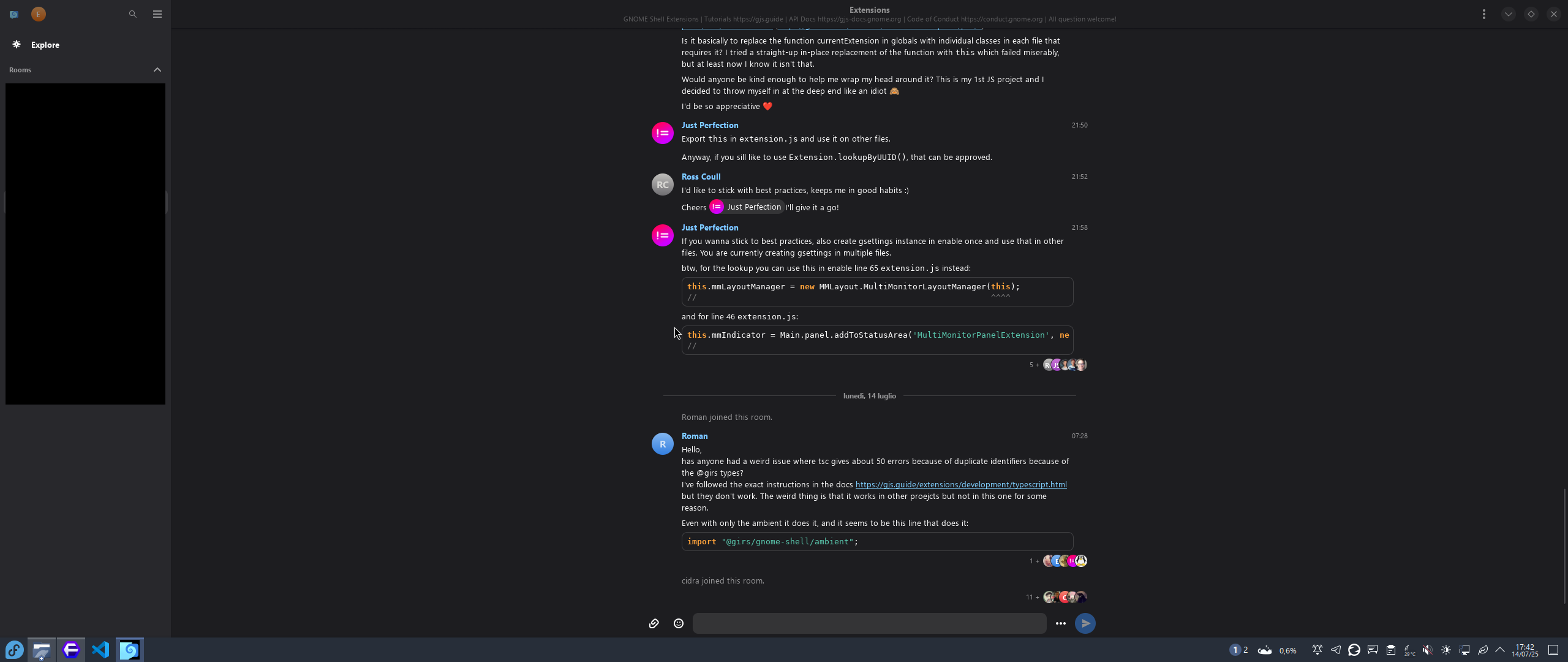AFAIK one of these are technical limitations, it’s just design choices. But in my experience, the design choices made following the gnome design guidelines tend to make apps with tiny faces
- 4 Posts
- 46 Comments
Gnome does have a lot of strong points, I personally use both
(after edit)
I have no issue with the text size, I have an issue with enormous empty space around the text. It’s fine if it’s not perfect on a 21:9 display, but this wouldn’t look good even on a 16:9 display.
I’m also fine with the text not taking up the entire width, I aggre that it’s less readable. But I think the window (not the text, the window) could utilise the width better.
I say that the messages could be a little more spread out (i.e. my massages could be a little to the right while other’s a little to the left) and just like the left sidepanel appears and disappears when the window is too thin, more sidebars could appear to the right when the window is very wide.
No, I want it to utilize the space a little bit more, this wouldn’t look good even on a 16:9 display. Which is a shame because when windowed it looks really good.
2560x1080 which is 21:9 full hd. Most programs don’t really handle 21:9 displays, but many GTK apps are particularly bad at it
Counterargument:


Admittedly this is a chat app, so there’s little to do. But still, it could stretch out a little bit more, maybe open the conversation info panel on the right


I have yet to read this, but. But the first part is like the internals of systemd, you won’t immediately need it.
If you want to make use of systemd, you can skip directly to where it explains unit files. You’ll soon see just how much it can do for you
You had to go out of your way for that. Not common sense. It’s still not water.
My definition is that if it’s something that common sense would call water, it’s water. This is the simple trick that defeats all stupid questions.
In your example, brine isn’t water because it’s brine, you even said that in the example.
And if you add food dye to a glass of water, it’s water but colored. Even with you yourself wrote the example implying that it should be water.
The oil with chalk emulsified in water has nothing to do with milk, what does it matter that it looks like milk. And as you yourself implied, it should not be considered water, but an emulsion of stuff.
And notice how I avoided talking percentages, I simply questioned your own common sense. You didn’t even think about it, and yet your common sense made the solution clear in your examples.
But even a genie can’t replace the water in milk with milk because it doesn’t make sense, so that cannot be the genie’s interpretation of the wish
Obviously that’s not what “replace all water with milk” means. It means just replacing the water in water form. Like oceans, rivers, and aqueducts. If it meant also the water content of other stuff like the body it just wouldn’t be possible, because milk is mostly water and you would have to replace that as well
If only…
Those are POSIX acls, and they suck
We could have had NFSv4 ACL, of which windows ACLs are a subset. In fact, every other unix os did… Except for Linux, they decided it didn’t fit well to Linux. And so we are stuck with UGO permissions, and posix ACLs.
I pronounce it spelling out only C H, but spelling them in my native language, so it sounds like “chee akka mod” and of course the same goes for “chee akka own”
Have you tried gnome connections? It’s more on the “quick and easy” rather than “professional” side, but maybe it does the job.
Tho I wonder whether it’s more of a windows-side issue… maybe windows 11 requires some kind of online authentication that cannot be implemented by other clients, and maybe this authentication can be turned off. I’m merely speculating here, but I know that remmina works for windows 10 so it’s suspicious.


AMD has an nvdec/nvenc equivalent called AMF, on Linux it’s going to be deprecated in months in favour of va-api.
To my knowledge, it does not have an nvfbc equivalent. Which anyway, Nvidia has deprecated on windows in favour of a windows-native screen capture with a name I don’t remember.
For what is worth, va-api encoding + kmsgrab works pretty well for me, it does have some latency, but nothing too unacceptable. Probably less than the one caused by the Bluetooth controller. And none of this is vendor specific, you can get it working on Intel, AMD and Nvidia (Nvidia needs a compatibility layer, but it works). Also, it works on Wayland, but sunshine needs some privileges to work.
Sunshine supposedly supports nvfbc with patched Nvidia drivers, even on Linux, I haven’t tried it, so I don’t know if it works on Wayland. I don’t see why it shouldn’t, as long as you give sunshine privileged permissions (like you need for kmsgrab). Even without nvfbc you can use nvenc, so you don’t need the va-api compatibility layer.
Supposedly, since this Nvidia driver release nvfbc is used as backend for pipewire screen capture, so it should just work for apps like OBS, I don’t know if sunshine has intention to move to it.
In general, screen capture on Linux pretty much works, even on Wayland. The general sentiment that it’s broken is actually old news.
There’s a caveat though. Proprietary apps tend to use outdated stuff (e.g. electron builds from 5 years ago) and thus don’t support screen sharing on Wayland.
It doesn’t replace the editor, it creates a stream and opens it in your default text editor. When you write out, it saves the stream to an appropriate drop in file
Fstab is still there untouched, it’s the temporary units files that get replaced at reload.
The mount program works as normally, if you edit fstab and then
mount -ait will work as expected, it will just warn you that systemd is not aware of the change. It will reload it anyway at the next boot.daemon-reload is not daemon-restart, it just makes systemd re-read the configuration to make it aware of the changes, but the services don’t get restarted. Some services (e.g. nginx) can re-read their confuration without restarting, those services are also made aware of the changes when reloading and can be reloaded individually.
You can edit any systemd units using
systemctl editso you don’t need to reload (fstab is not a systemd unit)
Fstabs gets converted into temporary unit files every time systems reloads config files (reboot or daemon-reload) so you can just keep using it like you always did. Actually it’s the systemd suggested way to manage mountpoints unless you need something advanced that fstabs can’t do.


I’ll have you notice that there’s also a gigachad in the meme, not just Kirk